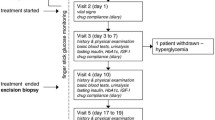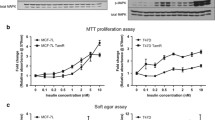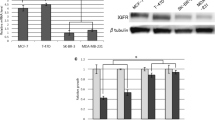Summary
Antiestrogens are widely used in the management of hormonally responsive breast cancer in both adjuvant and palliative settings, and are currently being evaluated as chemopreventive agents. The classical mechanism of action of these drugs involves inhibition of estrogen-stimulated neoplastic cell proliferation by blockade of estrogen receptors present on breast cancer cells. This paper reviews recent clinical and laboratory data that suggest that the commonly used antiestrogen tamoxifen also acts to reduce serum IGF-I levels. Estrogens appear to play a permissive role in growth hormone (GH) release by the pituitary gland and GH is known to stimulate IGF-I expression by hepatocytes. It is therefore possible that blockade of estrogen receptors in the hypothalamic-pituitary axis by tamoxifen interferes with GH release, leading to reduced hepatic IGF-I expression. In view of results suggesting that IGF-I is a more potent mitogen than estradiol for breast cancer cells and data demonstrating a positive correlation between estrogen receptor level and IGF-I receptor level of breast cancer cells, the IGF-I lowering effect of tamoxifen may contribute to the cytostatic activity of the drug. The interrelationships between steroid hormone physiology and IGF-I physiology may have relevance to a variety of commonly used treatments for hormonally responsive cancers.
Similar content being viewed by others
References
Sara VR, Hall K: Insulin-like growth factors and their binding proteins. Physiol Rev 70:591–614, 1990
Macaulay VM: Insulin-like growth factors and cancer. Br J Cancer 65:311–320, 1992
Pollak MN, Polychronakos C, Richard M: IGF-I is a potent mitogen for human osteogenic sarcoma. J Natl Cancer Inst 82:301–305, 1990
Pollak MN, Polychronakos C, Yousefi S, et al: Characterization of insulin-like growth factor I (IGF-1) receptors of human breast cancer cells. Biochem Biophys Res Commun 149:276–281, 1988
Rohlik QT, Adams D, Kull FC Jr, et al: An antibody to the receptor for insulin-like growth factor I inhibits the growth of MCF-7 cells in tissue culture. Biochem Biophys Res Commun 149:276–281, 1987
Arteaga CL, Osborne CK: Growth inhibition of human breast cancer cells in vitro with an antibody against the type I somatomedin receptor. Cancer Res 49:6237–6241, 1989
Furlanetto R, DeCarlo J: Somatomedin-C receptors and growth effects in human breast cells maintained in long term tissue culture. Cancer Res 44:2122–2128, 1984
De Leon DD, Bakker B, Wilson DM, et al: Demonstration of insulin-like growth factor (IGF-1 and -II) receptors and binding protein in human breast cancer cell lines. Biochem Biophys Res Commun 152:398–405, 1988
Osborne CK, Bolan G, Monaco ME Lippman ME: Hormone responsive human breast cancer in long term tissue culture:effect of insulin. Proc Natl Acad Sci USA 73:4536–4540, 1976
Arteaga CL, Kitten L, Coronado EB, et al: Blockade of the type I somatomedin receptor inhibits growth of human breast cancer cells in athymic mice. J Clin Invest 84:1418–1423, 1989
Duclos M, Houdebine LM, Djiane J: Comparison of insulin-like growth factor I and insulin effects on prolactin-induced lactogenesis in rabbit mammary gland in vitro. Mol Cell Endocrinol 65:129–134, 1989
Pollak MN, Perdue JF, Margolese RG, et al: Presence of somatomedin receptors on primary human breast and colon carcinomas. Cancer Lett 38:223–230, 1987
Pekonen F, Paranen S, Makinen T, et al: Receptors for epidermal growth factor and insulin-like growth factor I and their relation to steroid receptors in human breast cancer. Cancer Res 48:1343–1347, 1988
Peyrat JP, Bonneterre J, Beuscart R, et al: Insulin-like growth factor I receptors in human breast cancer and their relation to estradiol and progesterone receptors. Cancer Res 48:6429–6433, 1988
Berns EM, Klijn JG, van Staveren IL, Portengen H, Foekens JA: Sporadic amplification of the insulin-like growth factor I receptor gene in human breast tumors. Cancer Res 52:1036–1039, 1992
Foekens JA, Portengen H, van Putten WLJ, Trapman AMAC, Reubi JC, Alexieva-Figusch J, Klijn JGM: Prognostic value of receptors for insulin-like growth factor-1, somatostatin, and epidermal growth factor in human breast cancer. Cancer Res 49:7002–7009, 1989
Foekens JA, van Putten WLJ, Portengen H, Rodenburg CJ, Reubi JC, Berns PMJJ, Henzen-Logmans S, van der Burg MEL, Alexieva-Figusch J, Klijn JGM: Prognostic value of pS2 protein and receptors for epidermal growth factor (EGF-R), insulin-like growth factor-1 (IGF-1-R), and somatostatin (SS-R) in patients with breast and ovarian cancer. J Steroid Biochem Mol Biol 37:815–821, 1990
Pollak MN, Tremblay G: Immunocytochemical localization of insulin-like growth factor-I receptors in primary human breast cancers. Breast Cancer Res Treat 14:174, 1989
Yee D, Paik S, Lebovic GS, Marcus RR, Favoni RE, Cullen KJ, Lippman ME, Rosen N: Analysis of insulin-like growth factor I gene expression in malignancy: Evidence for a paracrine role in human breast cancer. Mol Endocrinol 3:509–517, 1989
D'Ercole AJ, Applewhite GT, Underwood LE: Evidence that somatomedin is synthesized by multiple tissues in the fetus. Devel Biol 75:315–328, 1980
D'Ercole AJ, Stiles AD, Underwood LE: Tissue concentration of somatomedin C: Further evidence for multiple sites of synthesis and paracrine or autocrine mechanisms of action. Proc Natl Acad Sci USA 81:935–939, 1984
Atkinson PR, Weidman ER, Bhaumick B, Bala RM: Release of somatomedin-like activity by cultured WI-38 human fibroblasts. Endocrinology 106:2006–2012, 1980
Clemmons DR, Underwood LE, Van Wyk JJ: Hormonal control of immunoreactive somatomedin production by cultured fibroblasts. J Clin Invest 67:10–19, 1981
Clemmons DR: Multiple hormones stimulate the production of somatomedin by cultured human fibroblasts. J Clin Endocrinol Metab 58:850–856, 1984
Roberts CT, Brown AL, Graham DE, Seelig S, Berry S, Gabbay KH, Rechler MM: Growth hormone regulates the abundance of insulin-like growth factor I RNA in adult rat liver. J Biol Chem 261:10025–10028, 1986
Mathews LS, Norstedt G, Palmiter RD: Regulation of insulin-like growth factor I gene expression by growth hormone. Proc Natl Acad Sci USA 83:9343–9347, 1986
DiPippo VA, Powers CA: Estrogen induction of growth hormone in the thyroidectomized rat. Endocrinology 129:1696–1700, 1991
Murphy LJ, Friesen HG: Differential effects of estrogen and growth hormone on uterine and hepatic insulin-like growth factor I gene expression in the ovariectomized hypophysectomized rat. Endocrinology 122:325–332, 1988
Florini JR, Prinz PN, Vitiello MV, Hintz RL: Somatomedin-C levels in healthy young and old men: Relationship to peak and 24-hour integrated levels of growth hormone. J Gerontol 40:2–7, 1985
Hintz R, Suskind R, Amatayakul K, Thanangkul O, Olson R: Plasma somatomedin and growth hormone values in children with protein-calorie malnutrition. J Pediatr 92:153–156, 1978
Miller AB, Kelly A, Choi NW, Matthews V, Morgan RW, Munan L, Burch JD, Feather J, Howe GR, Jain M: A study of diet and breast cancer. Am J Epidemiol 107:499–509, 1978
Straus DS, Takemoto CD: Effect of fasting on insulin-like growth factor-I (IGF-I) and growth hormone receptor mRNA levels and IGF-I gene transcription in rat liver. Mol Endocrinol 4:91–100, 1990
Tannenbaum GS, Ling N: The interrelationship of growth hormone (GH)-releasing factor and somatostatin in generation of the ultradian rhythm of GH secretion. Endocrinology 115:1952–1957, 1984
Jansson J-O, Eden S, Isaksson I: Sexual dimorphism in the control of growth hormone secretion in female rats. Endocrinology 121:1417–1423, 1987
Simard J, Hubert J-F, Hosseinzadeh T, Labrie F: Stimulation of growth hormone release and synthesis by estrogens in rat anterior pituitary cells in culture. Endocrinology 119:2004–2011, 1986
Wiedemann I, Schwartz E, Frantz AG: Acute and chronic estrogen effects upon serum somatomedin activity, growth hormone and prolactin in man. J Clin Endocrinol Metab 35:942–952, 1976
Jin L, Song J, Lloyd RV: Estrogen stimulates both prolactin and growth hormone mRNA expression in the MtT/F4 transplantable pituitary tumor. Proc Soc Exp Biol Med 192:225–229, 1989
LLoyd RV, Cano M, Landefeld TD: The effects of estrogens on tumor growth and on prolactin and growth hormone mRNA expression in rat pituitary tissues. Am J Pathol 133:397–406, 1988
Shulman DI, Sweetland M, Duckett G, Root AW: Effect of estrogen on the growth hormone (GH) secretory response to GH-releasing factor in the castrate adult female ratin vivo. Endocrinology 120:1047–1051, 1987
Ho KY, Evans WS, Blizzard RM, Veldhuis JD, Merriam GR, Samojlik E, Furlanetto R, Rogol AD, Kaiser DL, Thorner MO: Effects of sex and age on the 24-hour profile of growth hormone secretion in man: Importance of endogenous estradiol concentrations. J Clin Endocrinol Metab 64:51–58, 1987
Werner H, Koch Y, Baldino F Jr, Gozes I: Steroid regulation of somatostatin mRNA in the rat hypothalamus. J Biol Chem 263:7666–7671, 1988
Chowen-Breed JA, Steiner RA, Clifton DK: Sexual dimorphism and testosterone-dependent regulation of somatostatin gene expression in the periventricular nucleus of the rat brain. Endocrinology 125:357–362, 1989
Zeitler P, Argente J, Chowen-Breed JA, Clifton DK, Steiner RA: Growth hormone-releasing hormone messenger ribonucleic acid in the hypothalamus of the adult male rat is increased by testosterone. Endocrinology 127:1362–1368, 1990
McEwen BS, Davis PG, Parsons B, et al: The brain as a target for steroid hormone action. Ann Rev Neurosci 2:65–112, 1979
Cuttler L, Van Vliet G, Conte FA, et al: Somatomedin-C levels in children and adolescents with gonadal dysgenesis: Differences from age-matched normal females and effect of chronic estrogen replacement therapy. J Clin Endocrinol Metab 60:1087–1092, 1985
Minuto F, Barreca A, Del Monte P, Giordano G: Paracrine actions of IGF binding proteins. Acta Endocrinologica (Copenh) 124:63–69, 1991
Pollak M, Tetenes E, Maack C: Recombinant human insulin-like growth factor I binding protein 3 inhibits IGF-I-stimulated sarcoma cell proliferation [abs]. Proc Am Assoc Cancer Res 33:72, 1992
Colletti RB, Roberts JD, Devlin JT, et al: Effect of tamoxifen on plasma insulin-like growth factor I in patients with breast cancer. Cancer Res 49:1882–1884, 1989
Fisher B, Costantino J, Redmond C, et al: A randomized clinical trial evaluating tamoxifen in the treatment of patients with node-negative breast cancer who have estrogen-receptor-positive tumors. N Engl J Med 320:479–484, 1989
Pollak MN, Costantino J, Polychronakos C, Blauer S, Guyda H, Redmond C, Fisher B, Margolese R: Effect of tamoxifen on serum insulin-like growth factor I levels in stage I breast cancer patients. J Natl Cancer Inst 82:1693–1697, 1990
Friedl A, Jordan VC, Pollak M: Effect of tamoxifen on insulin-like growth factor I levels in breast cancer patients [abs]. Proc Am Soc Clin Oncology 11:52, 1992
Kiang DT, Kollander R, Kiang B, Kao PC: Role of plasma IGF-I in endocrine therapy for breast cancer [abs]. Proc Am Soc Clin Oncology 11:51, 1992
Lien EA, Johannessen DC, Aakvaag A, Lonning PE: Influence of tamoxifen, aminoglutethimide, and goserelin on human plasma IGF-I levels in breast cancer patients. J Steroid Biochem Mol Biol 41:541–543, 1992
Malaab SA, Pollak MN, Goodyer CG: Direct effects of tamoxifen on growth hormone secretion by pituitary cellsin vitro. Eur J Cancer: in press, 1992
Blanchard MM, Goodyer CG, Charrier J, Barenton B: In vitro regulation of growth hormone (GH) release from ovine pituitary cells during fetal and neonatal development: Effects of GH-releasing factor, somatostatin, and insulin-like growth factor I. Endocrinology 122:2114–2120, 1988
Painson J-C, Thorner MO, Krieg RJ, Tannenbaum GS: Short-term adult exposure to estradiol feminizes the male pattern of spontaneous and growth hormone-releasing factor-stimulated growth hormone secretion in the rat. Endocrinology 130:511–519, 1992
Jordan V: Effect of tamoxifen on initiation and growth of DMBA-induced rat mammary carcinomata. Eur J Cancer 12:419–424, 1976
Tannenbaum GS, Gurd W, Lapointe M, Pollak M: Tamoxifen attenuates pulsatile growth hormone secretion: Mediated in part by somatostatin. Endocrinology 130:3395–3402, 1992
Lien E, Solheim E, Ueland P: Distribution of tamoxifen and its metabolites in rat and human tissues during steady-state treatment. Cancer Res 51:4837–4844, 1991
Shirasu K, Stumpf WE, Sar M: Evidence for direct action of estradiol on growth hormone-releasing factor (GRF) in rat hypothalamus: Localization of [3H]estradiol in GRF neurons. Endocrinology 127:344–349, 1990
Lerner L, Jordan V: Development of antiestrogens and their use in breast cancer. Cancer Res 50:4177–4189, 1990
Knabbe C, Lippman M, Wakefield L, Flanders KC, Kasid A, Derynck R, Dixon RB: Evidence that transforming growth factor beta is a hormonally regulated negative growth factor in human breast cancer cells. Cell 48:417–428, 1987
Bates S, Davidson N, Valverius E, Freter CE, Dison RB, Tam JP, Kudlow JE, Lippman ME, Salomon DS: Expression of transforming growth factor alpha and its mRNA in human breast cancer:its regulation by estrogen and its possible functional significance. Mol Endocrinol 2:543–555, 1988
Jordan VC, Koerner S, Robison C: Inhibition of oestrogen-stimulated prolactin release by anti-oestrogens. J Endocrinol 65:151–152, 1975
Groom GV, Griffiths K: Effect of the anti-oestrogen tamoxifen on plasma levels of luteinizing hormone, follicle-stimulating hormone, prolactin, oestradiol and progesterone in normal pre-menopausal women. J Endocrinol 70:421–428, 1976
Pollak MN: Therapeutic implications of recent growth factor research.In Ragaz J, Ariel IM (eds) High-Risk Breast Cancer. Springer-Verlag, Berlin, 1991, pp 473–489
Pollak MN, Polychronakos C, Guyda H: Somatostatin analogue SMS 201–995 reduces serum IGF-I levels in patients with neoplasms potentially dependent on IGF-I. Anticancer Res 9:889–891, 1989
Fradkin JE, Eastman RC, Lesniak MA, Roth J: Specificity spillover at the hormone receptor — exploring its role in human disease. N Engl J Med 320:640–645, 1989
Barrett A, Morgan L, Raggatt PR, Hobbs JR: Bromocriptine in the treatment of advanced breast cancer. Clin Oncol 2:373–377, 1976
Pollak M, Poisson R, Major D, Gallant K: Octreotide with or without a prolactin suppressive agent for patients with breast cancer refractory to antiestrogens [abs]. Proc Am Soc Clin Oncology 11:87, 1992
Ray BS, Pearson OH: Hypophysectomy in treatment of disseminated breast cancer. Surg Clin North Am 12:419–433, 1962
Sterental A, Dominguez JM, Weissman C, Pearson OH: Pituitary role in the estrogen dependency of experimental mammary cancer. Cancer Res 23:481–485, 1962
Arafah B, Manni A, Pearson O: Effect of hypophysectomy and hormone replacement on hormone receptor levels and the growth of 7,12-DMBA-induced mammary tumors in the rat. Endocrinology 107:1364–1369, 1980
Ruggeri B, Klurfeld D, Kritchevsky D, Furlanetto R: Growth factor binding to 7,12-DMBA-induced mammary tumors from rats subject to caloric restriction. Cancer Res 49:4135–4141, 1989
Stewart A, Johnson M, May F, Westley B: Role of insulin-like growth factors and the type I IGF receptor in the estrogen-stimulated proliferation of human breast cancer cells. J Biol Chem 265:21172–21178, 1990
Freiss G, Rochefort H, Vignon F: Mechanisms of 4-hydroxytamoxifen anti-growth factor activity in breast cancer cells: Alteration of growth factor receptor binding sites and tyrosine kinase activity. Biochem Biophys Res Commun 173:919–926, 1990
Anon: Growth hormone therapy in elderly people. Lancet 337:1131–1132, 1991
Rudman D, Feller AG, Nagraj HS, Gergans GA, et al: Effects of human growth hormone in men over 60 years old. N Engl J Med 323:1–6, 1990
Brock CGD: Growth hormone deficiency: Features assessment and therapy.In DeGroot LJ (ed) Endocrinology. Saunders, Philadelphia, 1989, pp 351–362
Procter H, Singh L, Baum M, et al: Response of multicentric desmoid tumours to tamoxifen. Br J Surg 74:401, 1987
Warshaw AL, Fernandez-del Castillo C: Medical progress: Pancreatic carcinoma. N Engl J Med 326:455–465, 1992
Pollak MN, Sen A, Richard M, Tetenes E, Bell R: Inhibition of metastatic behavior of murine osteosarcoma by hypophysectomy. J Natl Cancer Inst 84: in press, 1992
Schwander JC, Hauri C, Zapf J, Froesck ER: Synthesis and secretion of insulin-like growth factor and its binding protein by the perfused rat liver: Dependence on growth hormone status. Endocrinology 113:297–305, 1983
Love R, Newcomb P, Wiebe D, Surawicz T, Jordan VC, Carbone PP, Demets DL: Effects of tamoxifen therapy on lipid and lipoprotein levels in post-menopausal patients with node-negative breast cancer. J Natl Cancer Inst 82:1327–1332, 1990
Moller A, Rasmussen LM, Thuesen L, Christiansen JS: Impact of human growth hormone on plasma lipoprotein concentrations. Horm Metabol Res 21:207–209, 1989
Author information
Authors and Affiliations
Rights and permissions
About this article
Cite this article
Pollak, M.N., Huynh, H.T. & Lefebvre, S.P. Tamoxifen reduces serum insulin-like growth factor I (IGF-I). Breast Cancer Res Tr 22, 91–100 (1992). https://doi.org/10.1007/BF01833337
Issue Date:
DOI: https://doi.org/10.1007/BF01833337




